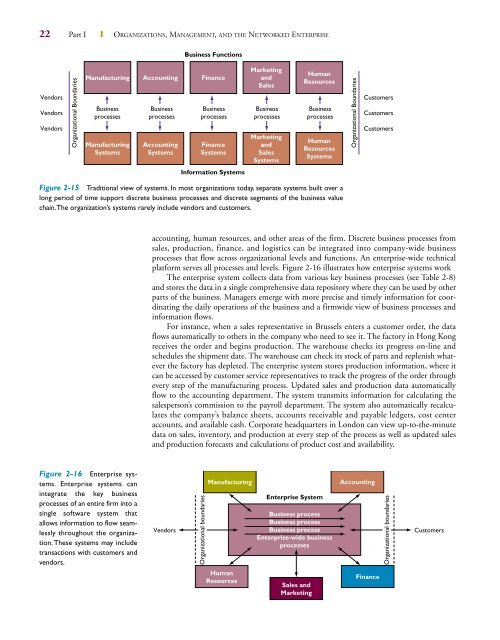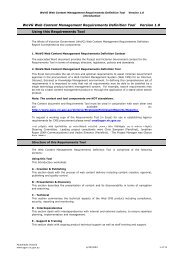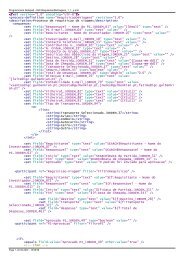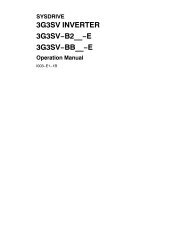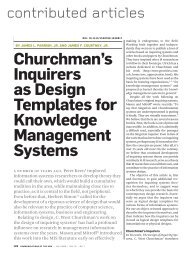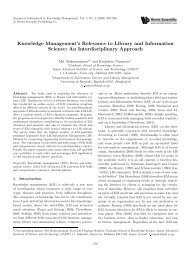2 Information Systems in the Enterprise - Main Web
2 Information Systems in the Enterprise - Main Web
2 Information Systems in the Enterprise - Main Web
You also want an ePaper? Increase the reach of your titles
YUMPU automatically turns print PDFs into web optimized ePapers that Google loves.
22 Part I ❙ ORGANIZATIONS, MANAGEMENT, AND THE NETWORKED ENTERPRISE<br />
Vendors<br />
Vendors<br />
Vendors<br />
Organizational Boundaries<br />
Manufactur<strong>in</strong>g Account<strong>in</strong>g F<strong>in</strong>ance<br />
Bus<strong>in</strong>ess<br />
processes<br />
Manufactur<strong>in</strong>g<br />
<strong>Systems</strong><br />
Figure 2-16 <strong>Enterprise</strong> systems.<br />
<strong>Enterprise</strong> systems can<br />
<strong>in</strong>tegrate <strong>the</strong> key bus<strong>in</strong>ess<br />
processes of an entire firm <strong>in</strong>to a<br />
s<strong>in</strong>gle software system that<br />
allows <strong>in</strong>formation to flow seamlessly<br />
throughout <strong>the</strong> organization.<br />
These systems may <strong>in</strong>clude<br />
transactions with customers and<br />
vendors.<br />
Bus<strong>in</strong>ess<br />
processes<br />
Account<strong>in</strong>g<br />
<strong>Systems</strong><br />
Vendors<br />
Bus<strong>in</strong>ess Functions<br />
Bus<strong>in</strong>ess<br />
processes<br />
F<strong>in</strong>ance<br />
<strong>Systems</strong><br />
<strong>Information</strong> <strong>Systems</strong><br />
Figure 2-15 Traditional view of systems. In most organizations today, separate systems built over a<br />
long period of time support discrete bus<strong>in</strong>ess processes and discrete segments of <strong>the</strong> bus<strong>in</strong>ess value<br />
cha<strong>in</strong>.The organization’s systems rarely <strong>in</strong>clude vendors and customers.<br />
account<strong>in</strong>g, human resources, and o<strong>the</strong>r areas of <strong>the</strong> firm. Discrete bus<strong>in</strong>ess processes from<br />
sales, production, f<strong>in</strong>ance, and logistics can be <strong>in</strong>tegrated <strong>in</strong>to company-wide bus<strong>in</strong>ess<br />
processes that flow across organizational levels and functions. An enterprise-wide technical<br />
platform serves all processes and levels. Figure 2-16 illustrates how enterprise systems work<br />
The enterprise system collects data from various key bus<strong>in</strong>ess processes (see Table 2-8)<br />
and stores <strong>the</strong> data <strong>in</strong> a s<strong>in</strong>gle comprehensive data repository where <strong>the</strong>y can be used by o<strong>the</strong>r<br />
parts of <strong>the</strong> bus<strong>in</strong>ess. Managers emerge with more precise and timely <strong>in</strong>formation for coord<strong>in</strong>at<strong>in</strong>g<br />
<strong>the</strong> daily operations of <strong>the</strong> bus<strong>in</strong>ess and a firmwide view of bus<strong>in</strong>ess processes and<br />
<strong>in</strong>formation flows.<br />
For <strong>in</strong>stance, when a sales representative <strong>in</strong> Brussels enters a customer order, <strong>the</strong> data<br />
flows automatically to o<strong>the</strong>rs <strong>in</strong> <strong>the</strong> company who need to see it. The factory <strong>in</strong> Hong Kong<br />
receives <strong>the</strong> order and beg<strong>in</strong>s production. The warehouse checks its progress on-l<strong>in</strong>e and<br />
schedules <strong>the</strong> shipment date. The warehouse can check its stock of parts and replenish whatever<br />
<strong>the</strong> factory has depleted. The enterprise system stores production <strong>in</strong>formation, where it<br />
can be accessed by customer service representatives to track <strong>the</strong> progress of <strong>the</strong> order through<br />
every step of <strong>the</strong> manufactur<strong>in</strong>g process. Updated sales and production data automatically<br />
flow to <strong>the</strong> account<strong>in</strong>g department. The system transmits <strong>in</strong>formation for calculat<strong>in</strong>g <strong>the</strong><br />
salesperson’s commission to <strong>the</strong> payroll department. The system also automatically recalculates<br />
<strong>the</strong> company’s balance sheets, accounts receivable and payable ledgers, cost center<br />
accounts, and available cash. Corporate headquarters <strong>in</strong> London can view up-to-<strong>the</strong>-m<strong>in</strong>ute<br />
data on sales, <strong>in</strong>ventory, and production at every step of <strong>the</strong> process as well as updated sales<br />
and production forecasts and calculations of product cost and availability.<br />
Organizational boundaries<br />
Manufactur<strong>in</strong>g<br />
Human<br />
Resources<br />
Market<strong>in</strong>g<br />
and<br />
Sales<br />
Bus<strong>in</strong>ess<br />
processes<br />
Market<strong>in</strong>g<br />
and<br />
Sales<br />
<strong>Systems</strong><br />
<strong>Enterprise</strong> System<br />
Bus<strong>in</strong>ess process<br />
Bus<strong>in</strong>ess process<br />
Bus<strong>in</strong>ess process<br />
<strong>Enterprise</strong>-wide bus<strong>in</strong>ess<br />
processes<br />
Sales and<br />
Market<strong>in</strong>g<br />
Human<br />
Resources<br />
Bus<strong>in</strong>ess<br />
processes<br />
Human<br />
Resources<br />
<strong>Systems</strong><br />
Organizational Boundaries<br />
Account<strong>in</strong>g<br />
Customers<br />
Customers<br />
Customers<br />
F<strong>in</strong>ance<br />
Organizational boundaries<br />
Customers


